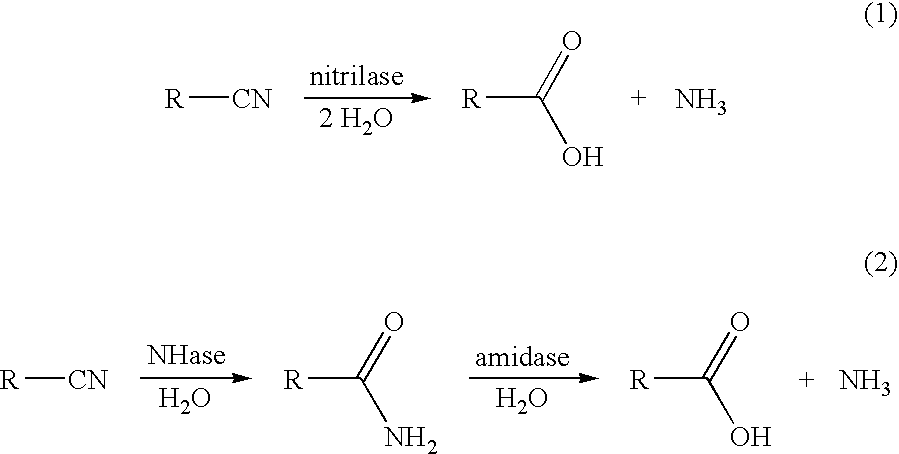Preparation of (E)- and (Z)-2-methyl-2-butenoic acids
a technology of methyl-2-butenoic acid and methyl-2-butenoic acid, which is applied in the direction of lyase, inorganic carrier, peptide, etc., can solve the problems of high reaction temperature, difficult distillation of this mixture, and large amount of unwanted waste of inorganic salts, etc., to achieve high regioselectivity
- Summary
- Abstract
- Description
- Claims
- Application Information
AI Technical Summary
Benefits of technology
Problems solved by technology
Method used
Image
Examples
example 1
Hydrolysis of (E)-2-Methyl-2-Butenenitrile to (E)-2-Methyl-2-Butenoic acid by E. coli SS1001 Cells
[0095] A 5.0 mL suspension of 0.500 g (wet cell paste) E. coli SS1001 cells (ATCC PTA-1177) in 50 mM potassium phosphate buffer (pH 7.0) was added to a mixture of 4.91 mL of 50 mM potassium phosphate buffer (pH 7.0) and 80.2 mg of (E)-2-methyl-2-butenenitrile (98.8 mM final concentration of (E)-2-methyl-2-butenenitrile), and the resulting suspension stirred at 35° C. Samples (0.100 mL) were mixed with 0.900 mL of 60 mM N-ethylacetamide (HPLC external standard) in 1:1 acetonitrile:methanol, the resulting mixture was mixed, centrifuged, and the supernatant analyzed by HPLC for (E)-2-methyl-2-butenenitrile and (E)-2-methyl-2-butenoic acid. After 2.5 h, the conversion of (E)-2-methyl-2-butenenitrile was 100%, and the yield of (E)-2-methyl-2-butenoic acid was 98%; no (E)-2-methyl-2-butenamide was produced over the course of the reaction.
example 2
Attempted Hydrolysis of (Z)-2-Methyl-2-Butenenitrile to (Z)-2-Methyl-2-Butenoic acid by E. coli SS1001 Cells (Comparative)
[0096] The procedure described in Example 1 was repeated, except that 79.2 mg of (Z)-2-methyl-2-butenenitrile (97.6 mM final concentration of (Z)-2-methyl-2-butenenitrile) was substituted for (E)-2-methyl-2-butenenitrile. After 3.0 h, the recovery of (Z)-2-methyl-2-butenenitrile was 100%, and there was no conversion to (Z)-2-methyl-2-butenoic acid (0% yield).
example 3
Reaction of a 1:1 Mixture of (E)- and (Z)-2-Methyl-2-Butenenitrile with E. coli SS1001 Cells
[0097] A 5.0 mL suspension of 0.500 g (wet cell paste) E. coli SS1001 cells (ATCC PTA-1177) in 50 mM potassium phosphate buffer (pH 7.0) was added to a mixture containing 4.91 mL of 50 mM potassium phosphate buffer (pH 7.0), 38.4 mg of (E)-2-methyl-2-butenenitrile (47.4 mM final concentration of (E)-2-methyl-2-butenenitrile), and 37.7 mg of (Z)-2-methyl-2-butenenitrile (46.5 mM final concentration of (Z)-2-methyl-2-butenenitrile), and the resulting suspension stirred at 25° C. Samples (0.100 mL) were mixed with 0.900 mL of 60 mM N-ethylacetamide (HPLC external standard) in 1:1 acetonitrile:methanol, the resulting mixture was mixed, centrifuged, and the supernatant analyzed by HPLC for (E)- and (Z)-2-methyl-2-butenenitrile and (E)- and (Z)-2-methyl-2-butenoic acid. After 23 h, the conversions of (E)-2-methyl-2-butenenitrile and (Z)-2-methyl-2-butenenitrile were 100% and 0%, respectively, and ...
PUM
| Property | Measurement | Unit |
|---|---|---|
| Temperature | aaaaa | aaaaa |
| Concentration | aaaaa | aaaaa |
| Concentration | aaaaa | aaaaa |
Abstract
Description
Claims
Application Information
 Login to View More
Login to View More - R&D
- Intellectual Property
- Life Sciences
- Materials
- Tech Scout
- Unparalleled Data Quality
- Higher Quality Content
- 60% Fewer Hallucinations
Browse by: Latest US Patents, China's latest patents, Technical Efficacy Thesaurus, Application Domain, Technology Topic, Popular Technical Reports.
© 2025 PatSnap. All rights reserved.Legal|Privacy policy|Modern Slavery Act Transparency Statement|Sitemap|About US| Contact US: help@patsnap.com

